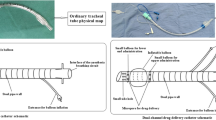Abstract
Background
The purpose of this study was to investigate endotracheal tube cuff pressure alteration in patients during laparoscopic cholecystectomy surgery.
Methods
Forty patients with ASA I–II physical status, who were scheduled for elective laparoscopic (group I) or open abdominal surgery (group II) were enrolled in the study. Tracheal intubation was always performed by an experienced anesthesiologist. The endotracheal tube cuff was inflated with air through a 10-ml syringe. The cuff was connected to a manometer. The endotracheal cuff pressure was registered every 5 min after tracheal intubation. At the time of discharge from the Post-Anesthesia Care Unit (PACU) and 12 h after tracheal extubation, patients were asked about their laryngotracheal condition by an independent observer who was uninformed of the patient allocation groups. We investigated laryngotracheal complaints such as sore throat, dysphasia, and hoarseness.
Results
The endotracheal cuff pressures in group I were significantly higher than those in the group II at all time points studied (P < 0.05). The endotracheal cuff pressures exceeded the critical pressure of 30 cmH2O after 5 min in the group I (intra-abdominal pneumoperitoneum was started). The incidence of sore throat was higher in group I than in group II in the PACU and at 12 h.
Conclusion
This study indicates that the CO2 pneumoperitoneum and Trendelenburg position used during laparoscopy increase endotracheal cuff pressure and lead to discomfort in the postoperative patient. Measurement of endotracheal cuff pressure is a simple and inexpensive procedure and should be applied in patients under going laparoscopic surgery.


Similar content being viewed by others
References
Combes X, Schauvliege F, Peyrouset O, Motamed C, Kirov K, Dhonneur G, Duvaldestin P (2001) Intracuff pressure and tracheal morbidity: influence of filling with saline during nitrous oxide anesthesia. Anesthesiology 95:1120–1124
Svenson JE, Lindsay MB, O’Connor JE (2007) Endotracheal intracuff pressures in the ED and prehospital setting: Is there a problem? Am J Emerg Med 25:53–56
Seegobin RD, van Hasselt GL (1984) Endotracheal cuff pressure and tracheal mucosal blood flow: endoscopic study of effects of four large volume cuffs. Br Med J (Clin Res Ed) 288:965–968
Gerges FJ, Kanazi GE, Jabbour-Khoury SI (2006) Anesthesia for laparoscopy: a review. J Clin Anesth 18:67–78
Casati A, Valentini G, Ferrari S, Senatore R, Zangrillo A, Torri G (1997) Cardiorespiratory changes during gynaecological laparoscopy by abdominal wall elevation: comparison with carbon dioxide pneumoperitoneum. Br J Anaesth 78:51–54
Rauh R, Hemmerling TM, Rist M, Jacobi KE (2001) Influence of pneumoperitoneum and patient positioning on respiratory system compliance. J Clin Anesth 13:361–365
Inoue S, Takauchi Y, Kuro M, Ninaga H (1998) Effects of changes in head and neck position on a tracheal tube cuff. Masui 47:1069–1072
Brimacombe J, Keller C, Giampalmo M, Sparr HJ, Berry A (1999) Direct measurement of mucosal pressures exerted by cuff and non-cuff portions of tracheal tubes with different cuff volumes and head and neck positions. Br J Anaesth 82:708–711
Tu HN, Saidi N, Leiutaud T, Bensaid S, Menival V, Duvaldestin P (1999) Nitrous oxide increases endotracheal cuff pressure and the incidence of tracheal lesions in anesthetized patients. Anesth Analg 89:187–190
Karasawa F, Ohshima T, Takamatsu I, Ehata T, Fukuda I, Uchihashi Y, Satoh T (2000) The effect on intracuff pressure of various nitrous oxide concentrations used for inflating an endotracheal tube cuff. Anesth Analg 91:708–713
Christensen AM, Willemoes-Larsen H, Lundby L, Jakobsen KB (1994) Postoperative throat complaints after tracheal intubation. Br J Anaesth 73:786–787
McHardy FE, Chung F (1999) Postoperative sore throat: cause, prevention and treatment. Anaesthesia 54:444–453
Canbay O, Celebi N, Sahin A, Celiker V, Ozgen S, Aypar U (2008) Ketamine gargle for attenuating postoperative sore throat. Br J Anaesth 100:490–493
Disclosure
Zeynep Baysal Yildirim, Ali Uzunkoy, Ali Cigdem, Suleyman Ganidagli, and Abdullah Ozgonul have no conflicts of interest or financial ties to disclose.
Author information
Authors and Affiliations
Corresponding author
Rights and permissions
About this article
Cite this article
Yildirim, Z.B., Uzunkoy, A., Cigdem, A. et al. Changes in cuff pressure of endotracheal tube during laparoscopic and open abdominal surgery. Surg Endosc 26, 398–401 (2012). https://doi.org/10.1007/s00464-011-1886-8
Received:
Accepted:
Published:
Issue Date:
DOI: https://doi.org/10.1007/s00464-011-1886-8




